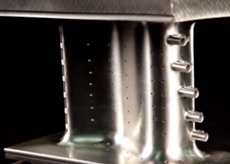Big data meets 3-D printing: big data to monitor laser-printed jet engine part
07 Jun 2013
Even in the lofty world of aerospace components, GE's new 3-D printed jet engine fuel nozzle is a rare bird. Workers build it as a single piece by welding together bits of super alloys dust with lasers. The new nozzle is 25 per cent lighter and as much as five times more durable than the current nozzle made from 20 different parts.
 But here's the rub. 3-D printing is so new that engineers have to develop new quality control methods before jumping into mass production. ''We are dealing with a microscopic weld pool that's moving at hundreds of millimeters per second,'' says Todd Rockstroh, a mechanical engineer at GE Aviation. ''Every cubic millimeter is a chance for a defect.''
But here's the rub. 3-D printing is so new that engineers have to develop new quality control methods before jumping into mass production. ''We are dealing with a microscopic weld pool that's moving at hundreds of millimeters per second,'' says Todd Rockstroh, a mechanical engineer at GE Aviation. ''Every cubic millimeter is a chance for a defect.''
Big data and sophisticated algorithms can help. GE Aviation is developing inspection technology that can collect and analyze manufacturing data and spot potential trouble like temperature anomalies while the part is still being made. ''When the weld pool is too small, things could be colder than they should be, when it's too big, it could be too hot,'' Rockstroh says.
How hot? The laser heats the alloy, a special blend of cobalt, chrome, and molybdenum, to more than 2,250 degrees Fahrenheit.
Big data tech will collect and analyze 3-D printing data to spot potential trouble during manufacturing.
Welders have monitored weld pools for centuries with shaded glasses, listening to the ''bacon sizzle'' of the molten metal, and later using infrared sensors, cameras, and pyrometers.
GE says it is collecting all this data, as well as information from sensors checking the mechanical stability of the 3-D printing machines and the laser beams, and feeding it into algorithms that reduce terabytes of raw data to megabytes of useful information.
''We are talking about monitoring large parts that take anywhere between 10 to 100 hours to produce,'' Rockstroh says. ''That's when it gets real tricky. It is critical to know how each cubic millimeter is being built and not trust that you are good enough at process control.''
The technology stores the data and allows engineers to pull it up later during X-ray and other conventional testing to determine what went wrong or worked well.
GE estimates that this ''in-process'' inspection technology could increase production speeds by 25 percent and reduce the time set aside for ''post-build'' inspection by the same about.
The savings will add up, says GE. The company will install 19 fuel nozzles into each next-gen LEAP jet engine manufactured by CFM International, a joint venture between GE Aviation and France's Snecma. CFM has orders for 4,500 LEAPs and GE plans to produce 100,000 3-D printed components for the LEAP as well as the GE9X engine, in development for Boeing's new 777X plane.




















